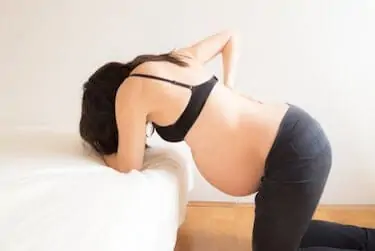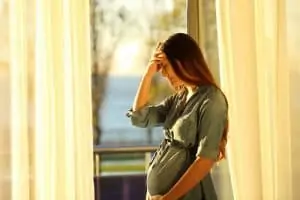You’ve heard all of your friends telling you that when your baby drops, labor and delivery are close, but when does your baby actually drop?
Dropping is commonly referred to as lightening, and it happens when your baby settles or drops lower into your pelvis as childbirth draws closer. However, just because it means your baby and body are preparing for labor doesn’t mean you’re about to go into labor. Don’t assume that dropping is a predictor of when labor will begin.
Relative: True vs. False labor.
You might not even notice, at first, that your baby dropped until a friend mentions that your belly looks differently. What does that mean, and when does your baby drop into your pelvis? Let’s take a look!
When Do Babies Typically Drop?
If you’re hoping your baby will drop between 30 to 35 weeks, it’s best not to hold your breath. Remember, you don’t WANT to go into labor that early; your baby will be premature and require a NICU stay.
It’s easy to believe your baby dropped at 33 weeks or 34 weeks, especially if it moves positions. Many times, I woke up between 32-35 weeks and thought my belly looked different.
Did my baby drop? 😮
Nope, she just moved positions. Within hours, my belly looked the same again.
When your baby drops is different for every woman. There is no set week or day that you should expect this to happen. For some women, it occurs just a few hours before labor begins. For other women, they can drop at 36 weeks and go into labor at 41 weeks.
All women are different, so it is complicated and nearly impossible to predict when it might happen to you.
For most women, this takes place 2-4 weeks before childbirth. That tends to be between 37 to 41 weeks. Somewhere in those weeks, you are most likely to experience lightening.
First-Time Mom vs. Experienced Moms
When your baby drops might depend on how many babies you’ve had before.

First-time mothers tend to experience dropping weeks before their body will go into labor. That might feel like torture because you’re so excited and think that dropping means your baby is coming soon. Remember, that’s not always true; your pelvis muscles need time to adjust to the new position before labor starts.
For women who have had babies before, dropping tends to happen closer to labor. Doctors suspect this is because their bodies have undergone labor before, so their pelvis needs less time to adjust.
How to Determine When Dropping Happens
Dropping doesn’t always feel like one shift motion with your baby suddenly dropping or sliding into a downward position. I’ve never felt this happening all at once. Typically, I just realized my baby dropped lower than before.
Here are some signs that your baby may have dropped.
Pelvic Pain
You might start noticing some flashes of pelvic pain and other discomforts. Some of these discomforts are due to your baby’s head pushing against ligaments in your pelvis. Your baby might be headbutting some other areas that might not feel great.
More Discharge
Since your baby sits lower and puts more pressure on your cervix, you might lose your mucus plug. A mucus plug sits at the top of your cervix until your pregnancy ends; it helps prevent bacteria from entering the uterus, potentially harming your baby.
Losing your mucus plug can happen over an extended time as your cervix thins and dilates. The discharge that comes out might be jelly or yolk-like, thicker than average discharge.
More Frequent Urination
Instead of struggling to breathe, you now have to urinate more often than before, which was still a lot. Since your baby sits lower in your pelvis, your baby is pressing on your bladder. It might feel like your baby is using your bladder as a trampoline all day.
Lower Belly
You might notice that your belly bump looks like it’s suddenly sitting lower now that your baby has dropped into your pelvis.
Pelvis Pressure Pain
Now that your baby dropped into your pelvis, it’s easy to understand why you might have more pressure pain. You have a lot more weight sitting down there now! This is also why you might start doing so if you weren’t waddling. The pressure leads to the signature pregnancy waddle.
Easier Breathing

One day, you might feel like you can’t take a breath. Your baby is pressing against your lungs and probably kicking your ribcage. Then, the next day, your baby is lower, leading to less pressure on your diaphragm. Easier breathing is something all pregnant women can appreciate.
Hemorrhoids
Now that your baby is pressing downwards, hemorrhoids are a side effect that isn’t pleasing. His head presses on the nerves throughout your rectum and pelvis when your baby drops. All of that pressure can lead to hemorrhoids.
Increased Back Pain
When your baby drops, it puts more pressure on the muscles throughout your lower back. Now, instead of your entire back hurting, the pain centers more on your lower back.
Increased Feeling of Hunger
You might have spent the last few weeks struggling to eat large meals. Your baby was sitting right on your stomach, increasing heartburn and decreasing your appetite. Small meals are your friend.
Now that your baby dropped, you’ll finally be able to eat more meals.
Expecting Your Baby to Drop
Your baby will drop into your pelvis somewhere between the 37th and 41st weeks. While this doesn’t mean your baby is coming today, it does mean your baby and body are getting ready for childbirth. Birth is in your future!
Hey, this is Linda. My biggest accomplishment in life is being a mother of four children. Their current ages range from almost ten years old down to 20 months old.
I’m passionate about writing parenting articles because I understand so well all of the problems and trials you face as a parent. From breastfeeding woes to budgeting problems and behavior problems, along with everything in between, chances are I’ve faced it over the last ten years. Read more about Linda here.






